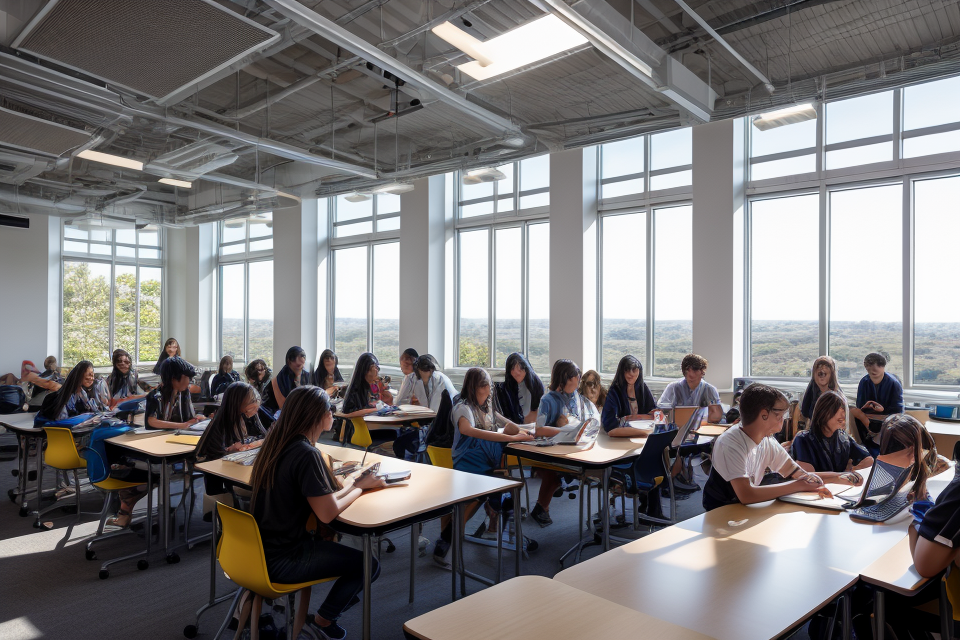
Optimization in education refers to the process of creating the most effective and efficient learning environment for students. It involves analyzing various factors such as teaching methods, study materials, and classroom layout to maximize learning outcomes. This guide aims to provide a comprehensive understanding of optimizing study environments, focusing on creating a conducive atmosphere for learning. Whether it’s improving concentration, motivation, or memory retention, this guide will provide practical tips and strategies to help students get the most out of their study time. Get ready to discover the secrets to maximizing your learning potential!
Creating a Productive Study Space
Factors Affecting Study Environment
- Noise levels
- The level of noise in a study environment can have a significant impact on a student’s ability to focus and learn.
- Excessive noise can be distracting and hinder the learning process, while too little noise can make it difficult to concentrate.
- The ideal noise level for a study environment is one that is calm and quiet, but not completely silent.
- Lighting
- Lighting is an essential factor in creating a productive study environment.
- The type of lighting used can affect a student’s mood, energy levels, and ability to concentrate.
- Natural light is often considered the best type of lighting for studying, as it can help to boost energy levels and improve mood.
- However, artificial lighting can also be effective, especially when used in combination with natural light.
- Temperature
- The temperature of a study environment can also affect a student’s ability to focus and learn.
- The ideal temperature for a study environment is usually between 18-20 degrees Celsius.
- Temperatures that are too hot or too cold can be distracting and make it difficult to concentrate.
- Ergonomics
- Ergonomics refers to the study of designing equipment and devices that fit the human body and its cognitive abilities.
- Ergonomics plays a crucial role in creating a productive study environment.
- A study environment that is ergonomically designed can help to reduce the risk of injury and discomfort, and improve posture and circulation.
- This can lead to increased comfort and productivity while studying.
Tips for Optimizing Study Environment
When it comes to creating a productive study space, the environment plays a crucial role in maximizing learning outcomes. Here are some tips for optimizing your study environment:
Choose a quiet and well-lit area
A quiet and well-lit area is essential for optimal studying. Look for a room or space that is free from noise and distractions, and has adequate lighting to prevent eye strain. If possible, choose a room with a window that allows natural light to flow in, or invest in good quality lighting to ensure proper illumination.
Adjust temperature and humidity levels
Comfortable temperature and humidity levels are crucial for effective studying. The ideal temperature for studying is between 60 and 68 degrees Fahrenheit, while the ideal humidity level is between 30 and 50 percent. Make sure to adjust the temperature and humidity levels in your study space to ensure optimal comfort.
Use ergonomic furniture
Ergonomic furniture is designed to support healthy posture and reduce the risk of injury or discomfort while studying. Invest in a comfortable chair with good back support, and a desk that is at the right height to prevent neck and back strain. Adjustable desks or standing desks can also be beneficial for mixing up your study position and reducing the risk of injury.
Minimize distractions
Minimizing distractions is crucial for optimal studying. Eliminate any unnecessary items in your study space, such as unnecessary books or papers, and keep your phone and other electronic devices out of reach. Consider using noise-cancelling headphones to block out distracting sounds, and create a study schedule to help you stay focused and avoid procrastination.
Enhancing Focus and Concentration
Maximizing Learning Outcomes: A Guide to Optimizing Study Environments highlights the importance of creating a productive study environment to maximize learning outcomes. Factors such as noise levels, lighting, temperature, and ergonomics play a crucial role in creating a productive study environment. Techniques for improving focus, such as note-taking, highlighting and underlining, self-questioning and reflection, and collaborative learning, can help students actively engage with course material, leading to improved understanding and retention of information. Additionally, fostering a growth mindset, developing effective study habits, and cultivating a supportive learning community can further enhance learning outcomes.
Techniques for Improving Focus
Time management
One effective technique for improving focus during study sessions is time management. This involves setting specific goals for each study session, prioritizing tasks, and creating a structured schedule. By breaking down study sessions into smaller, manageable blocks of time, students can avoid feeling overwhelmed and can stay focused on the task at hand. Additionally, by allocating specific amounts of time for each task, students can ensure that they are making the most of their study time and avoiding distractions.
Mindfulness
Another technique for improving focus is mindfulness. This involves paying attention to the present moment and being fully engaged in the task at hand. By practicing mindfulness techniques such as deep breathing, meditation, or yoga, students can improve their ability to concentrate and stay focused during study sessions. Additionally, mindfulness can help students reduce stress and anxiety, which can be major distractions during study sessions.
Breaks and exercise
Taking regular breaks and incorporating exercise into study routines can also help improve focus. By taking short breaks every hour or so, students can give their brains a chance to rest and recharge. Additionally, incorporating physical activity into study routines can help increase energy levels and improve concentration. Even a short walk or a few minutes of stretching can make a big difference in terms of focus and productivity.
Nutrition and hydration
Finally, proper nutrition and hydration can also play a key role in improving focus during study sessions. Eating a balanced diet that includes plenty of fruits, vegetables, and whole grains can help provide the brain with the nutrients it needs to function at its best. Additionally, staying hydrated by drinking plenty of water can help improve concentration and reduce fatigue. By making sure to eat well and stay hydrated, students can help ensure that they are able to stay focused and productive during study sessions.
Strategies for Overcoming Distractions
Distractions can significantly impede one’s ability to focus and learn. Therefore, it is crucial to implement effective strategies to overcome them. The following are some effective ways to minimize distractions and enhance concentration:
Minimizing digital distractions
Digital distractions, such as social media notifications, emails, and text messages, can be a significant hindrance to learning. To minimize these distractions, one can:
- Turn off notifications for non-essential apps
- Set aside specific times to check emails and messages
- Use apps that block distracting websites or limit screen time
Establishing boundaries
Creating boundaries between work and personal life can help minimize distractions. This can include:
- Setting aside specific times for work and study
- Designating a workspace that is separate from personal spaces
- Setting limits on the use of electronic devices during non-work hours
Setting goals and deadlines
Setting goals and deadlines can help create a sense of urgency and focus. This can include:
- Breaking down larger tasks into smaller, more manageable ones
- Creating a schedule or timeline for completing tasks
- Using a planner or organizer to keep track of deadlines and priorities
Prioritizing tasks
Prioritizing tasks can help focus on what is most important and minimize distractions. This can include:
- Identifying the most critical tasks and working on them first
- Eliminating unnecessary tasks or delegating them to others
- Avoiding multitasking, as it can reduce productivity and increase distractions.
Encouraging Active Learning
Importance of Active Learning
- Engagement and motivation
- Active learning requires learners to participate in the learning process actively, rather than passively receiving information. This involvement can increase motivation and interest in the subject matter, leading to a more positive attitude towards learning.
- Retention and understanding
- Active learning encourages learners to engage with the material and think critically about it, which can lead to better retention and understanding of the subject matter. Studies have shown that learners who engage in active learning techniques are more likely to remember and apply what they have learned.
- Application and problem-solving
- Active learning encourages learners to apply what they have learned to real-world situations and solve problems, which can help them develop critical thinking and problem-solving skills. These skills are highly valued in today’s workforce and can benefit learners in their personal and professional lives.
Techniques for Active Learning
Active learning is a method of engaging with course material that goes beyond passive absorption of information. By actively engaging with course material, students are able to better retain and understand the information, leading to improved learning outcomes. There are several techniques for active learning that students can use to optimize their study environments.
Note-taking and summarization
Note-taking is a key technique for active learning. When taking notes, it is important to focus on the most important information and to organize it in a way that makes sense to you. Summarizing information in your own words is an effective way to reinforce your understanding of the material. This can be done by creating flashcards or summarizing notes in a few sentences.
Highlighting and underlining
Highlighting and underlining are also effective techniques for active learning. When highlighting or underlining information, it is important to focus on key concepts and ideas. This helps to reinforce the information and make it easier to remember. Additionally, it can be helpful to review highlighted or underlined information regularly to ensure that it is still understood.
Self-questioning and reflection
Self-questioning and reflection are important techniques for active learning. By asking yourself questions about the material, you can better understand and retain the information. This can be done by reviewing notes and summarizing key concepts, or by discussing the material with others. Reflecting on the material after studying it can also help to reinforce your understanding and retention of the information.
Collaborative learning
Collaborative learning is another effective technique for active learning. By working with others, students can engage with course material in new and different ways, leading to improved understanding and retention. This can be done through group discussions, study groups, or other collaborative activities. Collaborative learning can also help to foster a sense of community and support among students, leading to improved motivation and engagement.
Fostering a Growth Mindset
Understanding Growth Mindset
- Belief in personal growth: A growth mindset is the belief that one’s abilities can be developed through dedication and hard work. This is in contrast to a fixed mindset, which holds that abilities are innate and cannot be changed.
- Embracing challenges and failures: With a growth mindset, one views challenges and failures as opportunities for growth and learning, rather than as threats or indicators of lack of ability. This allows for a more resilient and adaptable approach to learning and problem-solving.
- Persistence and resilience: Individuals with a growth mindset are more likely to persist in the face of difficulties and setbacks, and to bounce back from failures more quickly. This is because they see effort and perseverance as key factors in achieving success.
Strategies for Cultivating Growth Mindset
- Reframing failure as learning
- Surrounding oneself with positive influences
- Seeking feedback and constructive criticism
- Celebrating progress and achievements
Reframing failure as learning:
One of the most effective strategies for cultivating a growth mindset is to reframe failure as an opportunity for learning. When faced with setbacks or challenges, it can be tempting to give up or become discouraged. However, by reframing these experiences as opportunities to learn and grow, individuals can develop a more resilient and positive attitude towards their studies. This involves reflecting on what went wrong and identifying ways to improve in the future, rather than dwelling on the negative experience.
Surrounding oneself with positive influences:
Another key strategy for fostering a growth mindset is to surround oneself with positive influences. This can include seeking out mentors or role models who embody a growth mindset, as well as surrounding oneself with peers who are supportive and encouraging. By being around individuals who share a positive and optimistic attitude towards learning, individuals can more easily adopt a growth mindset themselves.
Seeking feedback and constructive criticism:
Feedback and constructive criticism are essential components of any learning process. By seeking out feedback from teachers, mentors, or peers, individuals can gain valuable insights into their strengths and weaknesses, and identify areas for improvement. It is important to approach feedback with a growth mindset, seeing it as an opportunity to learn and improve rather than a criticism. Constructive criticism should be welcomed and used as a tool for growth.
Celebrating progress and achievements:
Finally, it is important to celebrate progress and achievements along the way. By recognizing and acknowledging small successes, individuals can build confidence and motivation to continue learning. This can include setting small goals and rewarding oneself for meeting them, as well as acknowledging the effort and hard work that has gone into achieving a particular milestone. Celebrating achievements can help to reinforce a growth mindset, reminding individuals of their ability to learn and improve over time.
Developing Effective Study Habits
Benefits of Good Study Habits
Implementing good study habits can bring about a multitude of benefits for students, helping them to optimize their learning outcomes and achieve academic success.
- Reduced stress and anxiety: Students who adopt effective study habits are often better equipped to manage their time and prioritize their tasks, which can lead to a reduction in stress and anxiety levels. By creating a structured and organized study routine, students can feel more in control of their workload and better prepared to tackle their academic responsibilities.
- Improved memory and retention: Good study habits can also improve memory and retention, as they promote active engagement with course material. By using techniques such as summarizing key points, creating flashcards, and engaging in active recall practice, students can encode information more effectively and retain it for longer periods of time.
- Increased motivation and productivity: Finally, good study habits can boost motivation and productivity, as they create a sense of momentum and forward progress. By breaking down large tasks into smaller, more manageable chunks, students can build momentum and maintain a sense of progress, which can be a powerful motivator for continued effort and achievement.
Techniques for Developing Good Study Habits
Creating a schedule and routine
Creating a schedule and routine is a crucial technique for developing good study habits. It involves setting aside specific times each day or week for studying and creating a structured plan for how that time will be used. This approach can help students stay organized, focused, and motivated.
To create an effective schedule and routine, students should consider the following:
- Identifying the best times of day for studying based on their personal energy levels and the type of material they are studying.
- Setting realistic goals for the amount of time they will spend studying each day or week.
- Breaking down larger tasks into smaller, more manageable chunks to avoid feeling overwhelmed.
- Incorporating breaks and time for relaxation and self-care into their schedule to prevent burnout.
Prioritizing and breaking down tasks
Prioritizing and breaking down tasks is another effective technique for developing good study habits. This approach involves identifying the most important tasks and focusing on them first, while also breaking down larger tasks into smaller, more manageable chunks.
To prioritize and break down tasks, students should consider the following:
- Identifying the most important tasks or goals they need to achieve.
- Breaking down larger tasks into smaller, more manageable chunks to make them feel less overwhelming.
- Allocating time to each task based on its importance and level of difficulty.
- Avoiding multitasking, as it can lead to decreased productivity and increased stress.
Using memory aids and mnemonic devices
Using memory aids and mnemonic devices is a helpful technique for developing good study habits. These tools can help students remember and recall information more easily, particularly when studying complex or abstract concepts.
Some common memory aids and mnemonic devices include:
- Acronyms: using the first letter of each word in a phrase to create a new word or phrase (e.g., HOMES to remember the names of the Great Lakes).
- Chunking: breaking down information into smaller, more manageable chunks to make it easier to remember (e.g., breaking down a phone number into individual digits).
- Visualization: creating mental images or associations to help remember information (e.g., imagining a tree to remember the process of photosynthesis).
Practicing time management and organization
Practicing time management and organization is an essential technique for developing good study habits. This approach involves using tools and strategies to manage time effectively and stay organized, which can help students stay focused and productive.
Some time management and organization strategies include:
- Using a planner or calendar to schedule study sessions and track progress.
- Setting clear goals and deadlines for assignments and projects.
- Minimizing distractions by creating a quiet, clutter-free study environment.
- Using tools like highlighting, note-taking, and summarizing to stay organized and focused while studying.
By practicing these techniques for developing good study habits, students can maximize their learning outcomes and achieve their academic goals.
Cultivating a Supportive Learning Community
Importance of Social Learning
- Collaboration and group work
- Engaging in collaborative learning experiences with peers can provide a diverse range of perspectives and knowledge.
- Working together on projects or problem-solving activities can foster critical thinking and teamwork skills.
- Collaborative learning can also increase motivation and engagement by providing opportunities for social interaction and shared success.
- Sharing knowledge and resources
- Learning from others is a valuable opportunity to gain new insights and deepen understanding.
- Sharing resources such as notes, study guides, and textbooks can reduce individual workload and increase access to learning materials.
- Encouraging the exchange of knowledge and resources can foster a sense of community and collective responsibility for learning.
- Emotional support and motivation
- Having a supportive learning community can provide emotional encouragement and motivation during challenging times.
- Peers can offer comfort, reassurance, and advice, which can help alleviate stress and anxiety.
- Social support can also help students stay accountable and committed to their learning goals, increasing the likelihood of success.
Strategies for Building a Supportive Learning Community
One of the most effective ways to maximize learning outcomes is by cultivating a supportive learning community. A supportive learning community is a group of individuals who share a common goal of learning and growth, and who work together to achieve it. In this section, we will explore some strategies for building a supportive learning community.
Joining Study Groups and Clubs
Joining study groups and clubs is an excellent way to build a supportive learning community. Study groups and clubs provide a platform for individuals to come together and learn from one another. They offer a structured environment where individuals can discuss, debate, and share knowledge and ideas. By joining a study group or club, individuals can benefit from the collective knowledge and experience of others, and can also develop new skills and perspectives.
Seeking Mentorship and Guidance
Another strategy for building a supportive learning community is by seeking mentorship and guidance. Mentorship and guidance can provide individuals with a sense of direction and purpose, and can help them navigate the challenges and obstacles that they may encounter on their learning journey. Mentors can offer valuable advice, guidance, and support, and can help individuals develop the skills and knowledge that they need to succeed.
Utilizing Online Resources and Communities
Utilizing online resources and communities is another effective strategy for building a supportive learning community. Online resources and communities offer a wealth of information and opportunities for learning and growth. They provide access to a vast array of educational materials, including tutorials, courses, and webinars, as well as access to online communities and forums where individuals can connect and collaborate with others.
Providing Support and Encouragement to Others
Finally, providing support and encouragement to others is an essential strategy for building a supportive learning community. Support and encouragement can help individuals overcome the challenges and obstacles that they may encounter on their learning journey, and can help them stay motivated and engaged. By providing support and encouragement to others, individuals can build strong relationships and connections, and can also benefit from the positive energy and enthusiasm of others.
In conclusion, building a supportive learning community is essential for maximizing learning outcomes. By joining study groups and clubs, seeking mentorship and guidance, utilizing online resources and communities, and providing support and encouragement to others, individuals can build a strong and supportive learning community that can help them achieve their learning goals and objectives.
FAQs
1. What is optimization in education?
Optimization in education refers to the process of designing and arranging study environments in a way that maximizes learning outcomes. This involves making the most efficient use of available resources, including time, materials, and technology, to achieve the best possible results for students.
2. Why is optimization important in education?
Optimization is important in education because it allows students to make the most of their time and resources, leading to better learning outcomes. By optimizing their study environments, students can improve their productivity, focus, and motivation, which can all contribute to greater academic success.
3. What are some examples of optimized study environments?
Examples of optimized study environments include well-organized and clutter-free workspaces, access to appropriate technology and learning materials, comfortable seating and lighting, and a quiet and distraction-free atmosphere. These factors can all contribute to a more productive and effective learning environment.
4. How can I optimize my study environment?
To optimize your study environment, start by assessing your current workspace and identifying areas that can be improved. Consider factors such as organization, lighting, technology, and distractions. Then, make changes to address these issues, such as decluttering your workspace, investing in good lighting, or finding a quiet study spot. Finally, regularly evaluate and adjust your study environment to ensure that it continues to support your learning goals.


